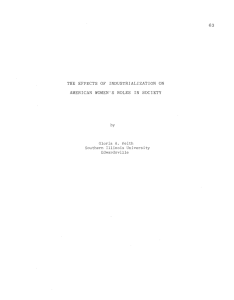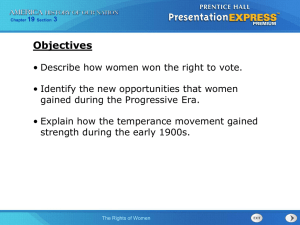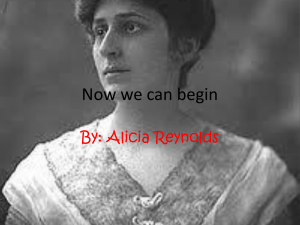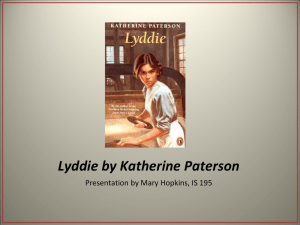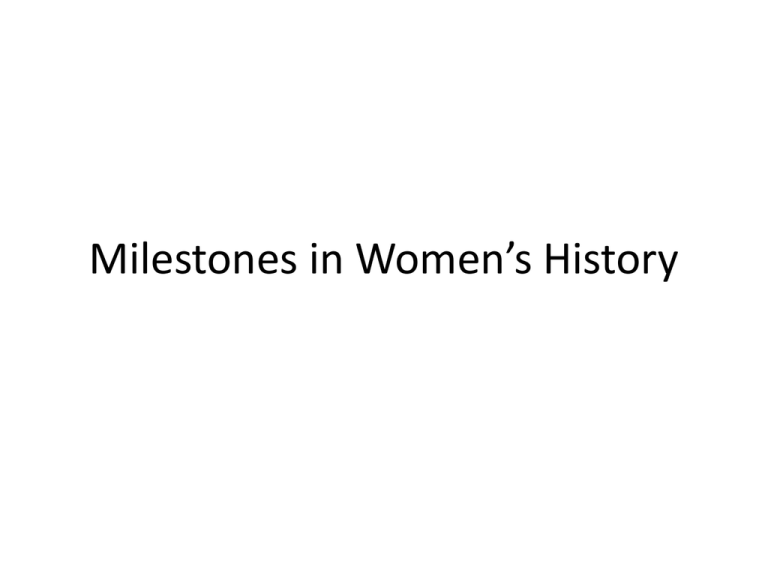
Milestones in Women’s History
Life in Colonial America, 1697-1789
Anne Hutchinson
Challenged Puritan religious authorities in
Massachusetts Bay.
Banished by Puritan authorities because she
challenged religious doctrine, gender roles, and
clerical authority, and claimed to have had
revelations from God.
Legal Status of Colonial Women
• Women usually lost control of their property
when they married.
• Married women had no separate legal identity
apart from their husband.
• Women could not hold political office, serve as
clergy, vote, or serve as jurors.
• Single women and widows did have the legal
right to own property.
• Women serving as indentured servants had to
remain unmarried until the period of their
indenture was over.
The Chesapeake Colonies
• There was a scarcity of women and a high
mortality rate among men. This was
especially true in the seventeenth century.
• As a result of the scarcity of women, the
status of women in the Chesapeake colonies
was higher than that of women in the New
England colonies.
The Early Republic, 1789-1815
Abigail Adams
• Abigail Adams was an early proponent of
women’s rights.
• Excerpt from famous letter she wrote to her
husband, John Adams:
“…I desire you would remember the ladies, and be
more generous and favorable to them than your
ancestors….”
The letter demonstrates that some colonial women
hoped to benefit from republican ideals of equality
and individual rights.
The Cult of Domesticity/Republican Motherhood
• The term “cult of domesticity” refers to the idealization
of women in their roles as wives and mothers.
• The term “republican mother” suggested that women
would be responsible for rearing their children to be
virtuous citizens of the new American republic. By
emphasizing family and religious values, women could
have a positive moral influence on the American
political character.
• Middle-class Americans viewed the home as a refuge
from the world rather than a productive economic unit.
Women in Antebellum America, 1815-1860
The Lowell System
• The Lowell System was a plan developed in the early
nineteenth century to promote and expand textile
manufacturing.
• During the first half of the nineteenth century, textile
mills in Lowell relied heavily on a labor force of women
and children.
• During the 1820s and 1830s, the majority of workers in
the textile mills of Massachusetts were young
unmarried women from rural New England who sought
to earn money of their own.
• Prior to the Civil War, Irish immigrants began to replace
New England farm girls in the textile mills.
The Seneca Falls Convention, 1848
• The Seneca Falls Convention was organized and led by
Elizabeth Cady Stanton and Lucretia Mott.
• The Seneca Falls Convention called for women’s rights
in the following areas: suffrage, the right to retain
property after marriage, equal educational
opportunities, and divorce and child custody rights
• The “Declaration of Sentiments and Resolutions”
issued by the convention demanded greater rights for
women. The declaration’s first sentence clearly states
this goal: “We hold these truths to be self-evident,
that all men and women are created equal.”
Characteristics of the Women’s
Movement in the Antebellum Period
• The movement was led by middle-class women.
• It promoted a broad-based platform of legal and
educational rights.
• It had close links with the antislavery and temperance
movements.
• It held conventions in the Northeast and Midwest but
not in the South.
• It supported all of the following goals:
–
–
–
–
Right of women to vote
Abolition of slavery
Passage of temperance laws
Right of married women to own property
Reformers and Suffragettes
1865-1920
Jane Addams
• Jane Addams is best known for founding Hull
House in Chicago.
• Hull House and other settlement houses became
centers of women’s activism and reform efforts to
help the urban poor. Settlement house workers
engaged in all of the following:
–
–
–
–
Teaching classes on cooking and dressmaking
Publishing reports on deplorable housing conditions
Offering literacy and language classes for immigrants
Establishing day nurseries for working mothers
The Fight for Suffrage
• Frontier life tended to promote the
acceptance of greater equality for women.
• The only states with complete women’s
suffrage before 1900 were located west of the
Mississippi. Wyoming (1869) was the first
state to grant women the full right to vote.
• The Nineteenth Amendment (1920)
guaranteed women the right to vote.
The Women’s Christian Temperance
Union (WCTU)
• Carry Nation was one of the best known and
most outspoken leaders of the WCTU.
• The WCTU successfully convinced many
women that they had a moral responsibility to
improve society by working for prohibition.
Women and the Progressive Reforms
• Dorothea Dix worked tirelessly on behalf of the
mentally ill.
• Ida B. Wells-Barnett was an African American civil
rights advocate and an early women’s rights
advocate. She is noted for her opposition to
lynching.
• Women reformers were also actively involved in
the following Progressive Era reforms:
– Passage of child labor legislation at the state level
– Campaigns to limit the working hours of women and
children
Women and the Workplace
• During the late nineteenth and early twentieth
centuries, the majority of female workers
employed outside the home were young and
unmarried.
• During the late nineteenth and early twentieth
centuries, women were most likely to work
outside their homes as one of the following:
–
–
–
–
Domestic servants
Garment workers
Teachers
Cigar makers
Boom and Bust, 1920-1940
Flappers
• Flappers symbolized the new freedom by
challenging traditional American attitudes
about women. They favored short bobbed
hair, smoked cigarettes, and even wore the
new one-piece bathing suit.
• In reality, few women actually lived the
flapper lifestyle. Nonetheless, the look was
very fashionable among college coeds, office
workers, and store clerks.
Women and the Workforce
• Although new jobs became available in offices
and stores, the percentage of single women in
the labor force actually declined between
1920 and 1930.
• Women did not receive equal pay and
continued to face discrimination in the
professions.
• Most married women did not seek
employment outside the home.
Margaret Sanger
• Margaret Sanger was an outspoken reformer
who openly championed birth control for
women.
Decline of the Feminist Movement
• The following factors caused a decline in the
organized feminist movement during the
1920s:
– The passage of the 19th amendment granting
women the right to vote.
– Changing manners and morality symbolized by the
flappers
– Dissension among women’s groups concerning
goals
– The decline of the Progressive Era movement
Women and the Workplace
1941-1960
World War II
• World War II stimulated a widespread movement
of women into factory work.
• During World War II, married women entered the
workforce in large numbers.
• “Rosie the Riveter” was a nickname given to
women who worked in America’s factories during
the war.
• Following World War II, women were encouraged
to give up their factory jobs and return home,
where they would devote themselves to being
wives and mothers.
The Modern Women’s Rights
Movement
Betty Friedan
• Betty Friedan wrote The Feminine Mystique and was the first
president of the National Organization for Women (NOW).
• Friedan was one of the founders of NOW—an organization founded
in 1966 to challenge sex discrimination in the workplace.
• Here is a famous excerpt from her book:
“The problem lay buried, unspoken, for many years in the
minds of American women. It was a strange stirring, a sense of
dissatisfaction….[as she] lay beside her husband at night—she was
afraid to ask even of herself the silent question—”Is this all?”
• Betty Friedan is best known for her criticism of traditional gender
roles.
The Expansion of Women’s Rights Since 1963
• All of the following contributed to the
expansion of women’s rights since 1963:
– The Equal Credit Opportunity Act of 1974
– The Supreme Court decision in Roe v. Wade which
legalized abortion
– Title VII of the Civil Rights Act of 1964
– Affirmative action regulations
The Equal Rights Amendment (ERA)
• The Equal Rights Amendment did not pass. So
the ERA is NOT an amendment.
• Phyllis Schlaffly led a campaign to block
ratification of the Equal Rights Amendment.
Female Vice-Presidential Candidates
• Geraldine Ferraro was the first woman
nominated for vice president by a major
political party. She was Democrat Walter
Mondale’s running mate in 1984.
• Sarah Palin was the first woman nominated
for vice president by the Republican Party.
She was John McCain’s running mate in 2008.



